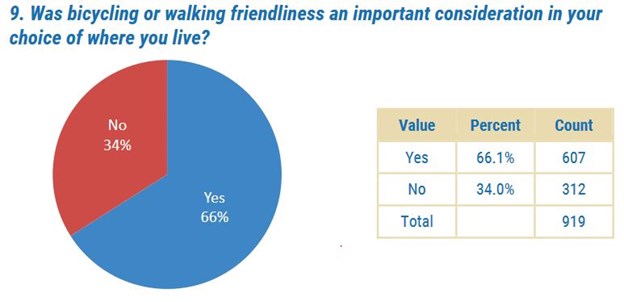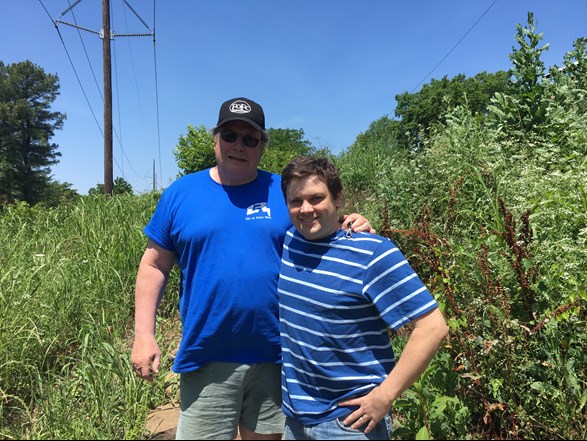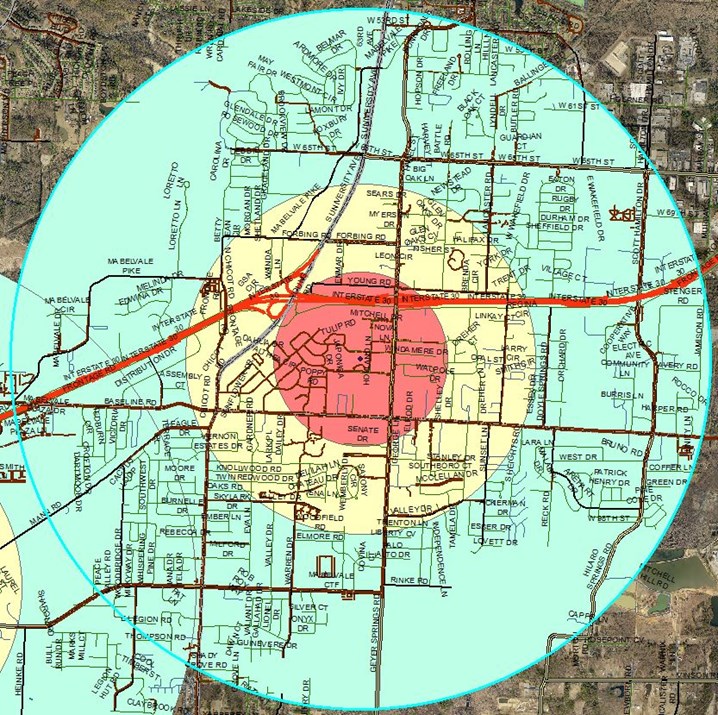Why BikePed?
Economics
Figure 1. The Arkansas Department of Health recently produced this video considering how livability is related to bicycle- and pedestrian-friendliness.
Arkansans Will Pay a Premium for BikePed
Livability refers to characteristics that make a place pleasant to live. Why should Little Rock be striving to increase livability? One reason is obvious: if livability defines the attributes we want in our community, then we should be working toward attaining them.
One attribute often associated with high livability scores is a bike- and pedestrian-friendly environment (Fig. 1). Arkansans link BikePed-friendliness with livability; in addition to the video above, an ArDOT survey (Appendix A) found that BikePed-friendliness was an important consideration for 66% of Arkansans in choosing where to live (Fig. 2). Little Rock Metro residents associate BikePed-friendliness with livability; Metroplan's Central Arkansas Livability Index considers how walkable and bikable our city is in its calculation (pg. 5-6).

Figure 2. Two out of three Arkansans polled in ArDOT's survey said that bike- and pedestrian-friendliness was an important consideration when choosing where to live (pg. A-5).
BikePed Attracts National and International Skilled Talent
Even if you never get on a bike or walk on a sidewalk, making our city BikePed-friendly benefits you. Why? Increasing livability makes our community more attractive to skilled employees who are marketable throughout the country and the world. Those talented professionals are typically good community members; attracting them to Little Rock is good for us.
BikePed Attracts Economic Investment
Attracting and retaining professionals also means attracting and retaining businesses that want to employ the best and brightest talent. Increasing BikePed-friendliness results in economic development. For example, in 2017, Amazon announced they were looking for a second North American headquarters. They shared their request for proposals (RFP) (defining the attributes they want in a community) publicly and asked cities to make their case that they are a good match. Not surprisingly, livability in general, and BikePed-friendliness specifically, made the eight-page RFP:
“We want to invest in a community where our employees will enjoy living, recreational opportunities, educational opportunities, and an overall high quality of life.”
“For each proposed site in your region, identify all transit options, including bike lanes and pedestrian access...”
Amazon's desire for their headquarters to be BikePed-friendly is not atypical (but sharing their RFP publicly was). Amazon's process gave Little Rock and other communities a gift; to share the attributes most important to businesses as they choose a community. Our efforts to create a BikePed-friendly Little Rock are directly related to our efforts to attract economic investment to Little Rock. Love Little Rock is an effective marketing campaign that sprung from Amazon's search, but the sentiment will have the most impact if it is translated into action, specifically the will to mobilize our resources to make Little Rock more BikePed-friendly. #lovelittlerock
Little Rock Understands the Importance of BikePed
The link between BikePed-friendliness and attracting professionals and business investment is not lost on our city. It is reflected in several "Must Do" Policy Statements of the City of Little Rock Board of Directors. Create Little Rock, part of the Little Rock Regional Chamber of Commerce, often creates temporary bicycle and pedestrian facilities with their Pop Up in the Rock events as part of their mission to "retain, attract, and develop young professional talent". The City's new full-time BikePed Coordinator position, the City's efforts to see the Arkansas River Trail and Southwest Trail completed, and our Complete Streets Ordinance are all reflections on the City's commitment to a BikePed-friendly Little Rock (Fig. 3).

Figure 3. Mayor Stodola and former BACA President Mason Ellis walk the proposed Central High Corridor/Southwest Trail route.
These efforts have yielded important successes. In 2015, Little Rock earned Bike Friendly Community status from the League of American Bicyclists. In 2016, our Complete Streets Ordinance was nationally recognized as one of the best by Smart Growth America. In 2017, the City was awarded $1.6M to make an important Arkansas River Trail connection. We will create a Master Plan that will help implement our Complete Streets Ordinance. We continue to build better bicycle and pedestrian facilities. This investment in livability has helped attract new professionals and businesses to our city, such as the Little Rock Technology Park.
However, in order to continue to make progress, we must acknowledge our challenges as well. A lack of sidewalk facilities and a sprawling development pattern has earned Little Rock last place in walkability among 52 communities studied by Metroplan (pg. 5, Fig. 4). Smart Growth America considers the Little Rock metro area the 14th most dangerous metro area for pedestrians in the country. We have high physical inactivity in part because our transportation system has prioritized the efficient movement of automobiles to the exclusion of people on bikes or on foot. These challenges are not unique to Little Rock. They have taken decades to create and will take years of focused commitment to solve. Elected officials and City staff have been working to increase BikePed-friendliness, but our continued focus depends on our community's demand for it.

Figure 4. This is a representation of sidewalk facilities 2 miles (bright blue circle), one mile (yellow circle), and 1/2 a mile from Cloverdale Middle School. Maroon lines represent where sidewalks exist, green and black lines represent roads without sidewalks. LRPS school buses will not pick up students who live within two miles of a middle school.
Other communities are making bold investments in livability as well. Northwest Arkansas, Oklahoma City, Memphis, Austin, and others all recognize the link between bicycle- and pedestrian-friendliness and economic investment and are working to increase their livabilities. We are competing with those cities for professional talent and business investment.
Maintaining a status quo means losing ground to these cities and becoming less competitive for professionals and businesses. Keeping pace with these cities makes us no more competitive than we are now. To make Little Rock's economy thrive, we must aggressively invest in making our city more welcoming to walking and biking as recreational opportunities and transportation options.




 Trash & Recycling
Trash & Recycling
 Online Payments
Online Payments
 City Documents
City Documents
 Parks
Parks
 Traffic Court
Traffic Court
 E-NEWS
E-NEWS
 EXPLORE
EXPLORE
 NEWS
NEWS
 TRANSLATE
TRANSLATE
